When Jefferson Davis set his hand and seal to this document, the Confederate Territory of Arizona became a full-fledged, legal reality.
The aspirations of the people of Arizona, which had been building since 1854, were finally realized. Arizona was born
Possibly, but it is known that during the debates which led to the admission of Arizona to the Union, articles appeared in several publications detailing the creation of the Confederate Territory and the fact that it pre-dated the United States Territory. . ."THE FORGOTTEN LEGACY
A Short History of the Confederate Territory of Arizona
by Robert Perkins
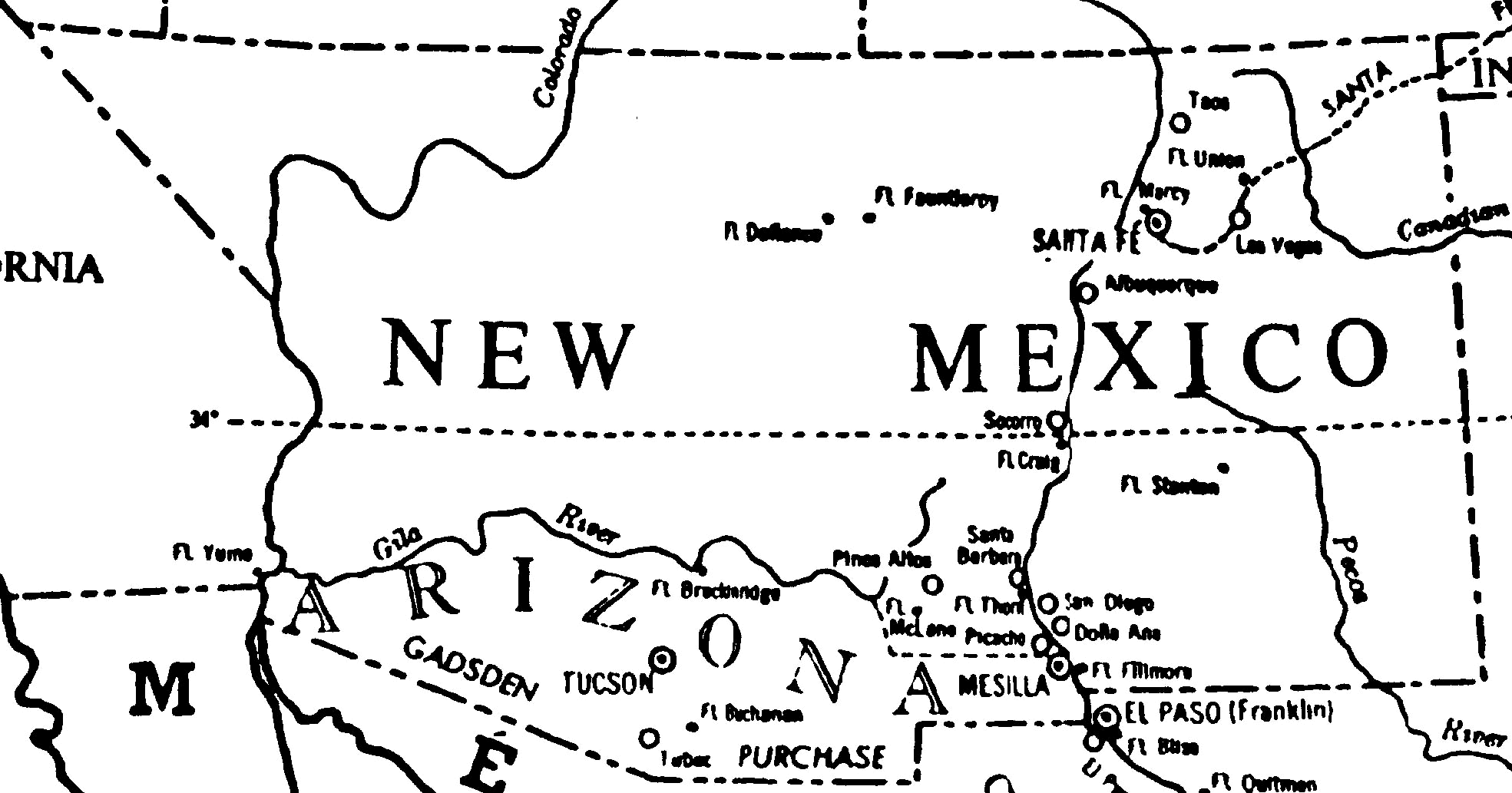
New Mexico Territory in 1861
The story of the Confederate Territory of Arizona can be said to have begun in 1854, when representatives of the United States and Mexico signed the Gadsden Purchase Treaty, by which the U.S. acquired disputed territories west of the Rio Grande and south of the Gila River, territories that comprise almost half of present-day Arizona and part of present-day New Mexico as well. These newly acquired lands were added to the United States Territory of New Mexico, creating a gigantic Territory which extended from the Texas border west to the Colorado River. The Territorial Government at Santa Fe was dominated by the northern counties, where most of the population lay, and the people of the southern region (which was at the time called "Gadsdonia," or more commonly, "Arizona") came to feel that their interests were being ignored. And in this they were, in large measure, correct.
As early as August 1856, Conventions were being held at Tucson and Mesilla (the two largest towns in the region called "Arizona") demanding that the United States Congress create a separate Territory of Arizona. However, due to the small number of people in the proposed Territory, the United States Congress refused to recognize the proceedings of any of these Conventions, and so the wishes of the people of Arizona were ignored.
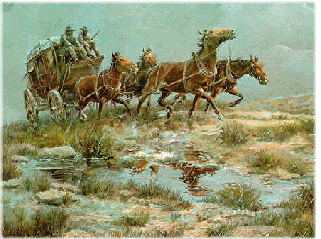
A Butterfield Overland Stagecoach
It was thus that matters stood when war clouds appeared over the Union in 1861. To make matters worse, in March 1861, the United States Government formally revoked the contract of the Butterfield Overland Stagecoach Company, which carried the United States mails on a route from San Antonio, Texas, through El Paso, Texas, Mesilla and Tucson to California. The loss of the Butterfield Stagecoach service virtually severed the region of Arizona from communication with the outside world, and demonstrated to the people therein that they were of minimal importance in the eyes of the United States Government.
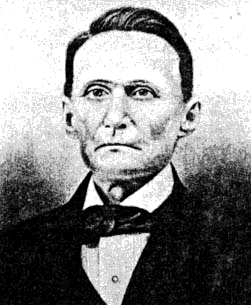
Mark Aldrich
It was thus that on March 16, 1861, another Convention was held at Mesilla for the purpose of considering what should be the future relationship between Arizona and the United States. At this Convention the people of Arizona voted to secede from the Union and to join their future to that of the Confederate States of America. On March 28, 1861, pursuant to the seventh resolution passed by the Mesilla Convention (which invited the citizens of the western portion of Arizona to "join us in this movement"), another Convention was held at Tucson. This Convention was chaired by Mark Aldrich (a man from Illinois who had been, ironically, a friend of both Stephen A. Douglas and Abraham Lincoln), who had been Tucson's first American mayor, and who was now the richest merchant in Tucson.

Granville Henderson Oury
The Tucson Convention ratified the proceedings of the Mesilla Convention, and elected provisional officers for the new Confederate Territory. Dr. Lewis Owings of Mesilla was elected Provisional Governor of the Territory, and Granville Henderson Oury of Tucson was elected as Delegate to the Confederate Congress. The Confederacy was not yet ready to accept new Territories, however, and so Arizona would have to wait again for Territorial status, for the time being.

It is not unlikely that if the United States had acted, in the wake of this rejection by the Confederacy, to meet the wishes of the people of Arizona, the Arizona secessionist movement might have been crushed before it really got started. But this was not to be, and indeed, the actions of the United States over the next few months served only to reinforce the desire of Arizonans to be separated from the Union. To a certain extent, this was unavoidable. On April 12, 1861, the tense situation concerning the status of the Federal garrison at Fort Sumter, South Carolina finally erupted into war between the Union and the Confederacy. Suddenly the United States Government was faced with the pressing need to build an army to crush the "rebellion" of the Southern States. The actions it took to do so had immediate impacts, both nationally and locally in Arizona.
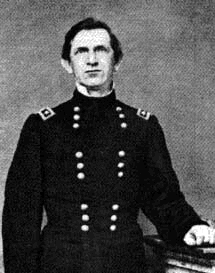
Col. Edward R. S. Canby, U.S. Army
In New Mexico Territory, the local commander of the United States forces, Colonel Edward R. S. Canby (pictured at left), ordered the Federal troops in the Territory be concentrated at the posts along the Rio Grande, in preparation for operations against Confederate forces from Texas. The practical effect of these orders was to completely denude Arizona of any U.S. troops. Forts Breckinridge and Buchanan, Arizona's only protection from the Apaches and the Mexican Banditos, were abandoned and burned. And, even more importantly, the Apaches themselves reacted to the removal of the Union soldiers by going on a rampage of killing, burning, and looting so severe that (according to one contemporary source) "the last glimmer of civilization semed about to be quenched in blood."
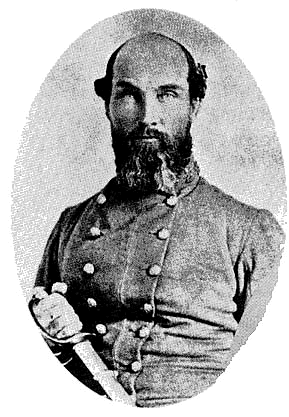
John Robert Baylor, Lt. Col., Second Texas Mounted Rifles
None of this served to instill pro-Union feeling in the region, and acts of open defiance to Federal authority became more and more frequent. Meanwhile, in Texas, other events were taking place that would have far-reaching consequences for Arizona. Shortly before the secession of Texas from the Union, John Robert Baylor, famous Texas lawyer, politician, and Indian fighter, had issued a call for 1,000 men to take part in a "buffalo hunt on the plains." In reality, Baylor was recruiting a Regiment of Mounted Rifles, whose purpose would be to confront the forces of the United States upon the secession of Texas from the Union, should those forces decide to resist the secessionist movement there. As it turned out, Baylor's force would be unnecessary for that purpose. But Baylor continued recruiting for his Regiment, which by April 1861 was fully manned and designated as the Second Regiment of Texas Mounted Rifles. Baylor and his new command were sent to occupy the now-abandoned Federal forts in far-west Texas...Camp Hudson, and Forts Clark, Lancaster, Stockton, Davis, Quitman, and finally, Fort Bliss, at El Paso, Texas. By the time Baylor reached Fort Bliss in July 1861, his command, which had initially numbered about 700 men, had dwindled to less than 400 due to desertion and the need to garrison the abandoned posts along the way.
Upon his arrival at Fort Bliss, Baylor became concerned by reports that large Union forces were concentrating at Fort Fillmore, near Mesilla and in easy striking range of his post at Fort Bliss. Baylor also consulted with several prominent men of the El Paso and Mesilla region, who informed him of the pro-Confederate feeling in Arizona. Baylor then made a momentus decision. He would lead his tiny force in an invasion of Arizona, defeat (and if possible capture) the Union force at Fort Fillmore, and he would support the pro-Confederate elements of the population in the creation of a Confederate Territory of Arizona. On July 23 he set out with 250 men (the remainder of his force being left behind as a garrison at Fort Bliss) for Mesilla.
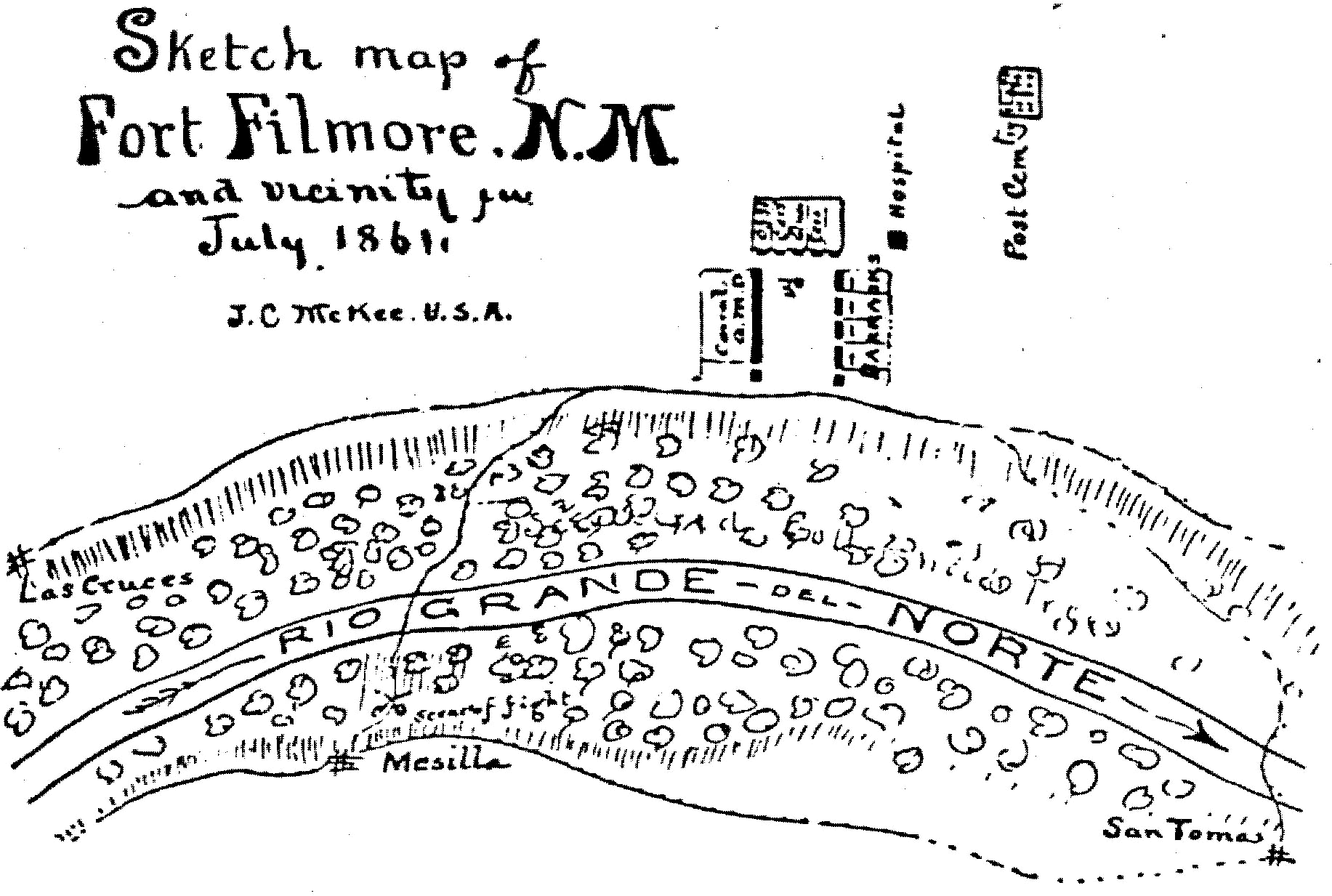
Major Isaac Lynde, Union commander at Fort Fillmore (a contemporary map of which appears above), soon learned of Baylor’s arrival at Mesilla, and upon discovering that Confederate troops were in the town, crossed the river with his entire force and demanded their surrender. Baylor refused, and Lynde ordered his men to attack. Union howitzers fired a couple of shots (which did no harm to Baylor's men, but scattered several townspeople who had gathered on a nearby hilltop to watch the fight), and the Union cavalry formed up to charge. As they did do they were hit by enfilade fire from one of Baylor's companies, which had taken up a position alongside the road leading into Mesilla. Three Union soldiers fell dead, and several others were wounded. The Union cavalry retreated in disorder, riding through their own infantry and throwing them into confusion. Major Lynde then ordered his force to retreat back to Fort Fillmore. The Confederates were too stunned by the sudden Union retreat to follow, and the battle was over.
Baylor expected the Unionists to return the next day, and ordered his men to fortify the town of Mesilla. But to his amazement, the first rays of daylight on July 26 revealed columns of black smoke rising from Fort Fillmore. Major Lynde, without consulting his staff, had decided to abandon the post and march his force to Fort Stanton, 154 miles to the northeast. Baylor soon discerned Lynde's plan, and ordered his men on a forced march to cut off the retreat of the Union force. Local scouts had told him of a pass through the Organ Mountains, about 4 miles south of San Augustine Springs, which were sure to be the first destination of Major Lynde's Union troops. If Baylor could get there before Lynde arrived, they could cut the Yankees off from the only available water supply in the area, and force their surrender.
Baylor's plan worked exactly as he wished. Riding hard, Baylor's men gathered up several hundred Union stragglers, who had foolishly filled their canteens with whiskey from the abandoned hospital stores at Fort Fillmore. They pushed on to the pass, and when Major Lynde arrived on July 27 he found Baylor's force drawn up in line of battle, blocking the way through the pass and access to the springs. Lynde's force still outnumbered that of Baylor by this time, but the Union troops were exhausted after their long, waterless march and in no condition to fight. Major Lynde, considering his options, decided to surrender. At one fell swoop, John Robert Baylor had captured the only significant Union force in the southern half of the New Mexico Territory.
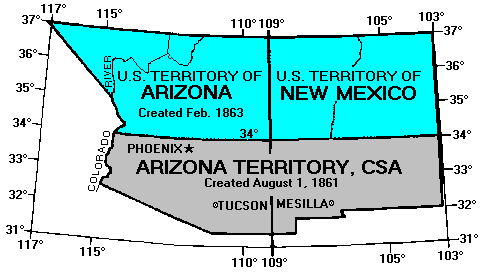
Map of the Confederate and Union Territories of Arizona and New Mexico
Returning to Mesilla, Baylor put in motion the second part of his plan. On August 1, he issued a "Proclamation to the People of the Territory of Arizona," which began as follows...
"The social and political condition of Arizona being little short of general anarchy, and the people being literally destitute of law, order, and protection, the said Territory, from the date hereof, is hereby declared temporarily organized as a military government until such time as Congress may otherwise provide.
I, John R. Baylor, lieutenant-colonel, commanding the Confederate Army in the Territory of Arizona, hereby take possession of said Territory in the name and behalf of the Confederate States of America.
For all purposes herein specified, and until otherwise decreed or provided, the Territory of Arizona shall comprise all that portion of New Mexico lying south of the thirty-fourth parallel of north latitude."
The proclamation went on to specify that two judicial districts were to be created to serve the Territory, to be based at Mesilla and Tucson. It also named a slate of officers for the Territory, and on August 2, 1861 Baylor appointed the first officers of the new Territory. As specified in the Proclamation, Baylor himself would be Territorial Governor. By the end of August all of the Territorial offices were filled. And indeed, it is interesting to note that the District Courts and Probate Courts of the new Territory were in operation almost immediately after Baylor declared them in existance. The records of the First District Probate Court (at Mesilla), for instance, begin on August 8, 1861, exactly one week after Baylor's proclamation. Thus, within a very short time, Confederate government in the Territory of Arizona was in operation.
It soon became apparent that the people of Arizona were firmly behind Baylor's creation of a Confederate Territory of Arizona. On August 28, 1861 a Convention of the People of Arizona was held at Tucson. This convention ratified Baylor's action of August 1, and elected a Delegate from the Territory of Arizona to the Confederate States Congress. Once again, Granville Henderson Oury was elected to this position (as he had at earlier conventions in April 1860 and March 1861). Governor Baylor accepted the proceedings of this Convention, including the nomination of Oury as Territorial Delegate, and by October 1, 1861, Granville Oury was on his way to Richmond, there to assume his seat in the Confederate Congress.
Upon Granville Oury’s arrival at the Confederate capital at Richmond, Virginia, events began to move swiftly toward the final resolution of Arizona’s status and its future relationship with the Confederate States of America. Oury met with President Jefferson Davis and other important Confederate leaders, and although he was not formally seated in the Confederate Congress as a delegate from the Territory of Arizona (as the said Territory did not as yet legally exist), he began to meet with Congressional leadership and to assist in drafting the legislation that would eventually lead to the formal creation of the Confederate Territory of Arizona.
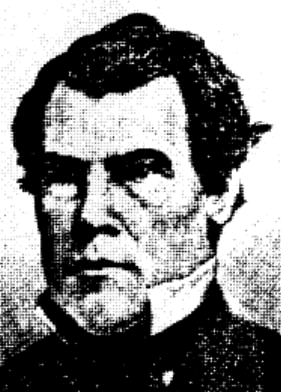
John H. Reagan
On November 22, 1861, John H. Reagan, a Texas Congressman and Postmaster General of the Confederacy, introduced a bill into the Confederate Congress which would formally create a Confederate Territory of Arizona. Granville Henderson Oury was active in the debates that resulted, and would see his efforts crowned with success. On January 13, 1862, after two months of debate and legislative wrangling, the Confederate Congress passed the "Act to Organize the Territory of Arizona," as the Reagan bill was called. The last section of the Act (Section 17) provided, however, that the provisions of the act would be in suspension until the President of the Confederate States issued a Proclamation declaring it to be in full force and effect and had appointed officers for the Territory. Thus, even though Congress had passed the Reagan bill, the Confederate Territory of Arizona still did not legally exist.

Jefferson Davis
This situation was to persist for another month, until February 14, 1862. On that date, President Jefferson Davis issued the following Proclamation: "I, Jefferson Davis, President of the Confederate States of America, do issue this, my proclamation, declaring said "Act to organize the Territory of Arizona" to be in full force and operation, and that I have proceeded to appoint the officers therein provided to be appointed in and for said Territory."
When Jefferson Davis set his hand and seal to this document, the Confederate Territory of Arizona became a full-fledged, legal reality. The aspirations of the people of Arizona, which had been building since 1854, were finally realized. Arizona was born.
EPILOGUE
Although it fell to foreign invaders in July 1862, the Confederate Territory of Arizona would leave a lasting legacy for the people of Arizona. For it was the creation of the Confederate Territory which finally moved the United States to create its own Territory of Arizona. The United States Congress passed its own "Act to Establish and Organize the Territory of Arizona" on February 24, 1863, over a year after the Proclamation of President Jefferson Davis had declared the Confederate Territory of Arizona to be in full force and operation.
The influence of the Confederate Territory of Arizona can also be seen in the boundaries chosen when the United States finally created its own Arizona Territory. Instead of the north/south division at the 34th parallel of north latitude chosen by the Confederates, the United States used an east/west division, the line running "due south from the point where the southwest corner of Territory of Colorado joins the Northern boundary of the Territory of New Mexico, to the southern boundary line of the said Territory of New Mexico." This line was chosen without regard to the natural divisions of geography and population that existed within the Territory, precisely because it differed from the line chosen by the Confederates. And it is this line that still marks the boundary between the States of New Mexico and Arizona today.
In a final bit of irony, it was on the fiftieth anniversary of the creation of the Confederate Territory of Arizona (February 14, 1912) that the State of Arizona was formally admitted into the Union. Was this just a coincidence? Possibly, but it is known that during the debates which led to the admission of Arizona to the Union, articles appeared in several publications detailing the creation of the Confederate Territory and the fact that it pre-dated the United States Territory. It is tempting to think that someone may have had this anniversary in mind, but we shall never really know.
The legacy of the Confederate Territory of Arizona is today forgotten by all save historians. Yet this legacy was a vital one for the people of Arizona, one that deserves to be remembered and celebrated today. It is hoped that this article will, in some small way, correct that injustice.
![]()


No comments:
Post a Comment